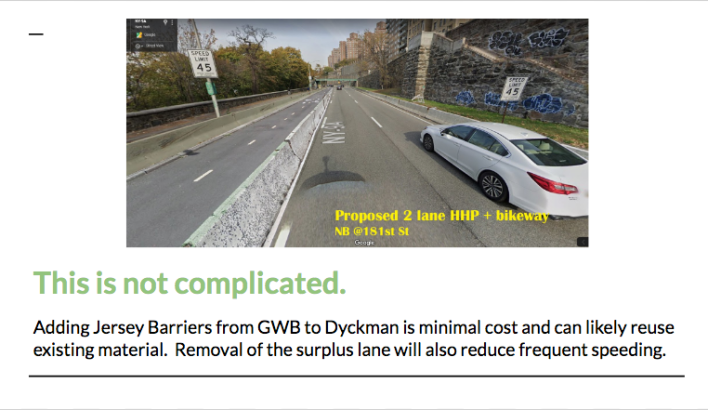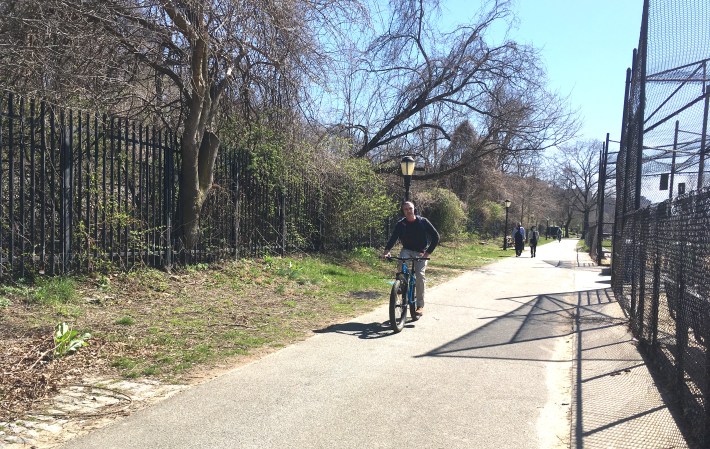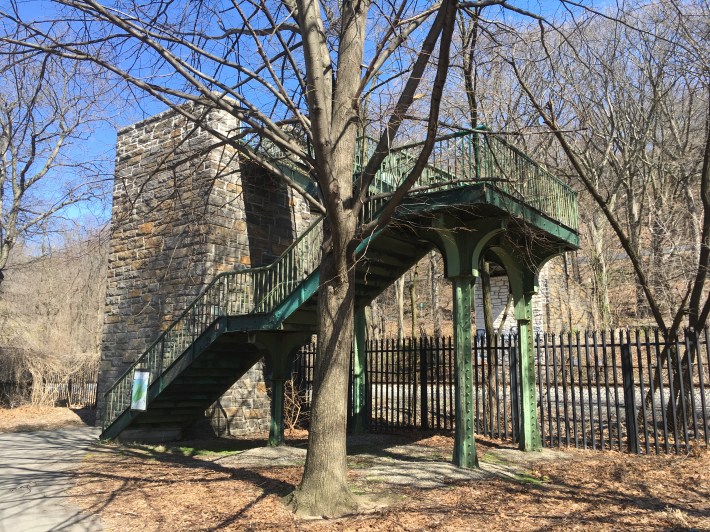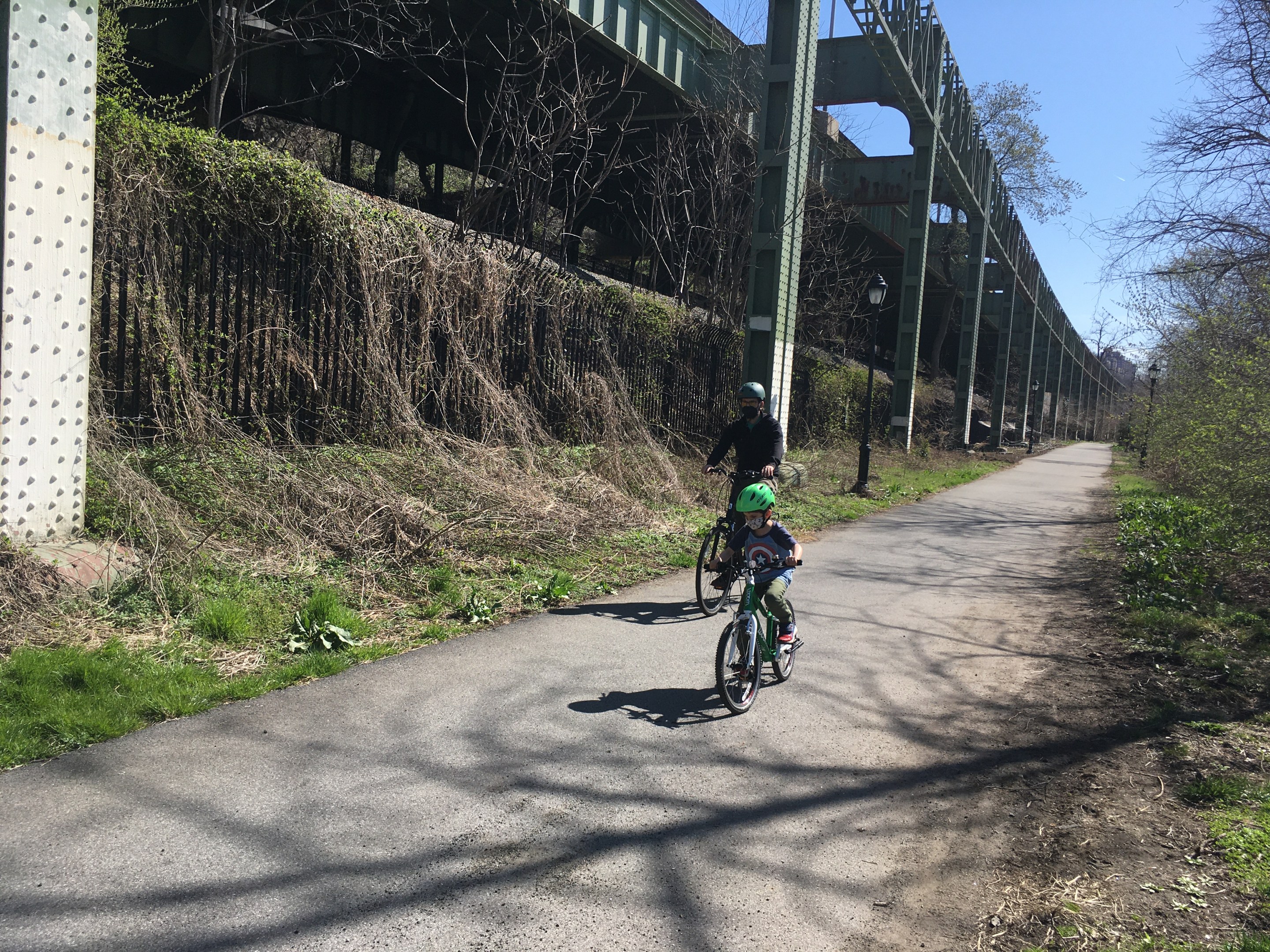A Manhattan civic panel has backed a community proposal to create a pilot bike lane on a northern stretch of the Henry Hudson Parkway — taking a lane away from car drivers.
Community Board 12, which covers Washington Heights and Inwood, voted unanimously on Tuesday night (with one abstention) to ask the city's Parks and Transportation departments to study the proposal, which neighborhood cycling activists started pushing earlier this year after Parks disclosed plans to close a pivotal section of the riverfront Hudson Greenway.
The repairs to fix a retaining wall of the Henry Hudson Parkway between the George Washington Bridge and Dyckman Street — more than a mile of the greenway — are expected to begin at the end of the year and last at least four months. But the advocates hope to use the occasion to test the idea that the little-used western lane of the three-lane, northbound Parkway could be cordoned off with inexpensive concrete barriers to become a serviceable bike lane — all the way over the Henry Hudson Bridge into the Bronx.

“The greenway … is too heavily used and too critical of a link to simply close off entirely for such a long period,” their proposal states. “Therefore the need to create a temporary alternative creates an opportunity to test out a more permanent expansion potential solution.”

Advocates argue that the project, besides creating a safe detour during the greenway closure, could also provide an ingenious fix for a glaring problem: how to hook up the Hudson River Greenway in Manhattan with the newly finished Empire State Trail, which runs through Van Cortlandt Park and the Kingsbridge neighborhood in the Bronx into southern Westchester and beyond.
"You could think longer term about improving the ability to get to the Bronx," CB12 Traffic and Transportation Committee Chairwoman Deborah Navabian said during the meeting Tuesday,
The state recently spent $200 million on the 75 percent off-road trail, which runs 750 miles between Manhattan and the Canadian border (plus a western spur between Albany and Buffalo) and rates as the longest multi-use trail in the country. There is a precedent for taking a highway lane for bike/pedestrian uses in order to facilitate the Empire State Trail; it happened upstate on Route 100.
It would really help: The path from the greenway in Manhattan leading to the trail in the Bronx is extremely arduous for cyclists and pedestrians. It requires them to mount a footbridge with a high staircase over Amtrak train tracks in Inwood Hill Park, climb steep switchbacks and then cross the Henry Hudson Bridge on a narrow, three-foot-wide, shared path — only to encounter more stairs before they can access trail signs on local streets. Family and disability friendly it is not.


“It’s pretty challenging,” said Inwood resident Allegra LeGrande, a proponent of the project, who bikes the greenway often with her children. LeGrande noted that efforts were made to connect the George Washington Bridge bike/ped path to the greenway as part of a recent revamp. Why not give the Henry Hudson Bridge, which has a lot of extra space, a real bike lane so that it could serves as a true Empire State Trail/greenway connection? The fact that the detour for the greenway closure presumably will dump cyclists on unprotected local streets also rankled LeGrande.
“When car lanes get shut down, motorists get barriers; when pedestrians lose a sidewalk, they get walkways. When the greenway gets closed, cyclists are told, ‘You’re on your own,’” she said.
The proposal adopted by CB12 is only the latest bid to carve out space for cycling on a stretch of New York City’s westernmost roadway. Last fall, advocates and officials dismayed by crowding on the Hudson River Greenway proposed a one-way, protected bike lane for West Street (formerly the West Side Highway, the continuation of the HHP south of the GWB) between 57th Street and the Battery. State Department of Transportation officials nixed the idea, despite the support it had garnered from three local community boards and nine elected officials. Activists for some years have also agitated for a protected bike lane in the traffic circle atop the Rotunda at 79th Street, which serves as an exit of the parkway and is undergoing a revamp. The city DOT has agreed only to establish a painted bike lane there, even though the traffic circle functions as a major biking entrance into Riverside Park.
The Henry Hudson Bridge, constructed by Robert Moses in the mid-1930s, remains among the bridges that car-centric bureaucrats adamantly refuse to make more hospitable to bikers and walkers.

Cycling activist and Bronx native Ed Ravin notes that during the last 30 years planners have been steadily increased the vehicular space on the Henry Hudson Parkway and the Henry Hudson Bridge, removing green space from Inwood Hill Park and widening the highway’s curves in order to make them safer for northbound motorists who refuse to obey the 50 mph speed limit. Planners even removed a sidewalk from the bridge's upper level, in order to create a narrow roadway shoulder for cars. The bike-lane proposal is a necessary corrective to such measures, in his view.
“Under the Bloomberg administration, NYC DOT reclaimed street space throughout the city (including at Times Square, Delancey Street, and the Bronx Hub) and used it to create pedestrian plazas, two-way bike lanes and other amenities,” Ravin said. “This greenway proposal follows the same strategy — take away excess roadway capacity that only encourages speeding and unsafe operation, and repurpose it for people who aren't inside automobiles.”
Unfortunately, even as the community board has embraced the proposal, there is little appetite for it among the city and state agencies that control our roads. Community board resolutions are only advisory.
The director of the Empire State Trail, Andy Beers, told activists not to get their hopes up. "I have checked with several state agency partners and confirmed currently there is not a NYS role in the city’s proposed project," Beers responded to a group letter. He later confirmed to Streetsblog that the situation has not changed.
The city also basically has no interest in making any HHP bike lane happen, even as a temporary detour. The DOT told Streetsblog that is would be happy to review the proposal, which it claimed not to have seen. (Advocates said they shared it with then-Acting DOT Commissioner Margaret Forgione.) At the March CB12 meeting, Parks Department representative Jennifer Hoppa said, however, that that "at the moment the city is not planning on redesigning the highway" in order to accommodate the greenway closure.
Will the proposal — and the community board's resolution — change any minds? Stay tuned.






